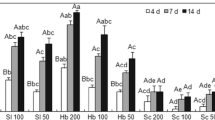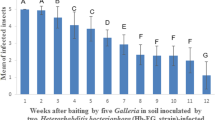Abstract
Experiments were conducted to study the efficacy of the insect parasitic nematodeHeterorhabditis sp. (HW79) as a biological control agent ofOtiorrhynchus salicicola. This weevil species is reported as a pest of ornamental plants in Switzerland and Italy. Dipping plastic boxes containing heavily infested cuttings of laurel (Prunus laurocerasus) in a nematode suspension resulted in approximately 100% parasitisation of full-grown larvae, pupae and non-emerged young adults. The average dose resulting from dipping varied between 56,000 and 62,000 nematodes per liter soil. This experiment was run under natural outdoor conditions. In a further outdoor experiment, pottedLigustrum plants were inoculated with eggs ofO. salicicola and later 20,000 infective juvenile nematodes per liter soil were added to the soil surface. The resulting weevil mortality in the treated pots was 78%. In seven greenhouse tests using the same nematode dose in pots with horticultural soil to which weevil larvae had been added, weevil mortality varied between 76% and 100%, the arithmetic average being 90%. These results indicate that Heterorhabditid nematodes may provide an effective means of controllingO. salicicola.
In an other experiment usingO. sulcatus larvae, the influence of application time on nematode efficacy was investigated. When nematodes were added a few days before weevil larvae had hatched from the eggs, no parasitic effect was obtained. Nematode applications done shortly after larval hatching however, resulted in complete weevil control. These results are of significance in timing nematode applications in practice.
Résumé
Des expériences ont été réalisées pour étudier les possibilités de lutte biologique contre les larves d'Otiorrhynchus salicicola au moyen des nématodes entomophagesHeterorhabditis sp. (HW79). Cet otiorrhynque est un ravageur de plantes ornementales en Suisse et en Italie. En plongeant des pots en plastique contenant des boutures infestées dePrunus laurocerasus dans une suspension de nématodes, près de 100% des larves, chrysalides et jeunes adultes du ravageur étaient parasités par les nématodes. La dose résultant de cette méthode d'application variait entre 56 000 et 62 000 nématodes par litre de terre. Dans des expériences complémentaires additionnelles, où la suspension était versée par arrosage, l'efficacité atteignait des valeurs comprises entre 76% et 100%. Dans ces cas, la dose exacte appliquée était de 20 000 nématodes par litre de terre.
Une expérience conduite avecO. sulcatus comme hôte avait pour but d'étudier l'influence du temps d'application — par rapport au développement des larves — sur l'efficacité des nématodes. Si ceux-ci étaient appliqués quelques jours avant l'apparition des larves d'otiorrhynque, il n'y avait aucun parasitisme. Si les applications avaient lieu quelques jours après l'éclosion des larves, l'effet était complet.
Similar content being viewed by others
References
Bedding, R. A. — 1981. Low costin vitro mass production ofNeoaplectana andHeterorhabditis species [Nematoda] for field control of insect pest. —Nematologica, 27, 109–114.
Bedding, R. A. &Miller, L. A. — 1981. Use of a nematode,Heterorhabditis heliothidis, to control black vine weevil,Otiorrhynchus sulcatus, in potted plants. —Ann. Appl. Biol., 99, 211–216.
Deseö, K. V., Costanzi M. & Orsi, E. — 1986. Control of pests with insect parasitic nematodes in protected crops.In: Fundamental and applied aspects of invertebrate pathology (R. A. Samson, J. M. Vlak & D. Peters, eds.) —Proc. 4th Int. Colloq. of Invert. Pathology, veldhoven (NL), 18–22 August 1986, p. 327.
Freude, H., Harde K. W. &Lohse, G. A. — 1981. Die Käfer Mitteleuropas, Bd. 10. —Verlag Goecke & Evers, Krefeld.
Gaugler, R., Lebeck, L., Nakagaki B. &Boush, G. M. — 1980. Orientation of the entomogenous nematodeNeoaplectana carpocapsae to carbon dioxide. —Environ. Entomol. 9, 649–652.
Georgis, R. &Poinar, G. O. — 1984. Greenhouse Control of Black Vine WeevilOtiorrhynchus sulcatus [Col.: Curculionidae] by Heterorhabditis and Steinernematid Nematodes. —Environ. Entomol., 13, 1138–1140.
Klinger, J. — 1959. Biologische Beobachtungen über den Gefurchten Dickmaulrüssler [Otiorrhynchus sulcatus Fabr.] während seines Massenauftretens der letzten Jahre auf Reben der deutschen Schweiz. —Landw. Jahrb. Schweiz, 73, 409–438.
Klingler, J. — 1963. Die Orientierung vonDitylenchus dipsaci in gemessenen künstlichen und biologischen CO2-Gradienten. —Nematologica, 9, 185–199.
Klingler, J. — 1986. Einsatz und Wirksamkeit insektenparasitischer Nematoden gegen den Gefurchten Dickmaulrüssler. —Gärtnermeister, 89, 277–279.
Lozzia, G. C. &Biraghi, C. — 1983. Curculionidi del Gen.Otiorrhynchus Germ. e loro controllo nei vivai del nord Italia. —La difesa delle piante, 5, 269–280.
Rutherford, T. A., Trotter, D. &Webster, J. M. — 1987. The potential of Heterorhabditid nematodes as control agents of root weevils. —Can. Entomol., 119, 67–73.
Simons, W. R. — 1981. Biological Control ofOtiorrhynchus sulcatus with Heterorhabditid nematodes in the glasshouse. —Neth. J. Pl. Path., 87, 149–158.
Stimmann, M. W., Kaya, H. K., Burlando, T. M. &Studdert, J. P. — 1985. Black Vine Weevil management in nursery plants. —Calif. Agric., 39, 25–26.
Author information
Authors and Affiliations
Rights and permissions
About this article
Cite this article
Klingler, J. Investigations on the parasitism ofOtiorrhynchus salicicola andO. Sulcatus [Col.: Curculionidae] byHeterorhabditis sp. [Nematoda]. Entomophaga 33, 325–331 (1988). https://doi.org/10.1007/BF02372622
Issue Date:
DOI: https://doi.org/10.1007/BF02372622




